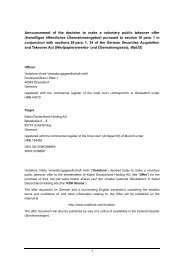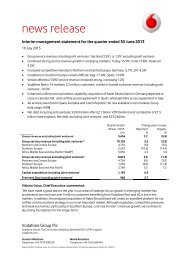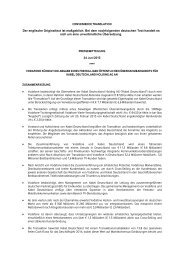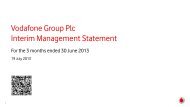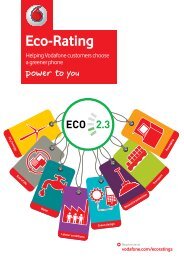Create successful ePaper yourself
Turn your PDF publications into a flip-book with our unique Google optimized e-Paper software.
Moving the debate forward • The Policy Paper Series • Number 8 • April 2008<br />
and off-net calls differ then “tariff-mediated network externalities” are created,<br />
because subscribers care about which network the people they want to call are on.<br />
10 “Response to Consultation and Notification to the European Commission –<br />
Wholesale voice call termination on individual networks”, Comreg Doc.<br />
No. 04/62a, 8th June 2004.<br />
11 See para. 4.35.<br />
12 It is also possible to consider different interpretations of welfare maximisation.<br />
Given that we are dealing with models of imperfect competition, the same<br />
solution may not maximise profits, consumer surplus and total welfare. From the<br />
policy perspective it is a matter of debate whether the appropriate welfare<br />
benchmark should be total welfare, or consumer surplus. I try and draw a clear<br />
distinction in the discussion that follows.<br />
13 Consumers are assumed to be located along a line. Two competing firms locate<br />
one at each end of the line. Consumers are assumed to choose one of the firms<br />
based on a trade off between the utility they would get from each firm and the<br />
“cost” of buying from each firm. The utility they get depends on the prices each<br />
firm offers. The cost of buying from a firm is assumed to be a linear function of<br />
the distance from the consumer to each firm. The lower is this cost the more<br />
competitive will be the market.<br />
14 The proof of this and other results discussed here is presented in Annexe 1.<br />
15 Including linear demand or constant elasticity demand within normal bounds<br />
for the elasticity.<br />
16 Calling Party Pays.<br />
17 In the absence of externalities.<br />
18 It should be noted that while consumer surplus is maximised by raising access<br />
charges above cost, total welfare is maximised in this model by cost-based access<br />
charges. The implications of this for policy depend on the extent to which the<br />
authorities value producer surplus as opposed to consumer surplus.<br />
19 Competition Commission (2003), <strong>Vodafone</strong>, O2, Orange and T-Mobile. See also<br />
Comreg Doc. No. 04/62a.<br />
20 In the absence of on-net/off-net differentials, perceived marginal cost will be the<br />
average marginal cost of on-net and off-net calls, taking into account the access<br />
charge on off-net calls.<br />
21 The large network’s subscribers will make more calls to the small network than<br />
will be made from the small to the large network.<br />
22 These results are, of course, sensitive to the intensity of competition between the<br />
networks. However, for an equilibrium to exist across the range of access charges<br />
shown here competition cannot be too intense. My sensitivity analysis indicates<br />
that, for any values for the intensity of competition parameter t that allow stable<br />
equilibria in this range, the impact of access charges on profits is very small indeed.<br />
23 For very small values of this parameter it can be shown that there are no stable<br />
internal equilibria.<br />
24 In practice it is my view that such an asymmetry is extreme and unlikely to be<br />
relevant to a real world example. Actual market shares may be split in this way<br />
in the short-run, especially shortly after a the launch of a new network. There<br />
is no reason, however, to believe that a single network should permanently<br />
hold such a huge intrinsic advantage that cannot be competed away over time.<br />
Nevertheless, I use this extreme asymmetry to illustrate clearly the qualitative<br />
results generated by these models.<br />
25 This measure of consumer surplus excludes network specific benefits, which I<br />
take to be a modelling device to create asymmetries.<br />
26 However, I would question how realistic a scenario is which posits a huge intrinsic<br />
asymmetry in networks co-existing with a highly competitive retail market.<br />
27 It should be emphasised that these two strategies are not equally easy. In the<br />
latter case it is not clear how a larger incumbent could force a smaller network<br />
to accept high reciprocal access charges, especially if the smaller network had<br />
recourse either to a competition or regulatory authority.<br />
28 In this modelling I have assumed an intrinsic asymmetry of 67/33, which I believe<br />
represents a reasonable upper bound.<br />
29 Schiff, A. (2001), “Two-way interconnection with partial consumer participation”,<br />
University of Auckland Working Paper # 223.<br />
30 The former is modelled by assuming that potential subscribers have an<br />
option value associated with joining the market, which is randomly distributed.<br />
Once the decision to subscribe is made, based on expected benefits from<br />
joining, the subscriber chooses network in the same way as in the other models<br />
discussed here. All subscribers still make the same volume of calls. Schiff by<br />
models network externalities assuming that the calls made by each subscriber<br />
are a linear function of the number of subscribers.<br />
31 This is modelled by assuming the number of calls made by each subscriber is a<br />
function of the price of calls but is not affected by the number of subscribers.<br />
32 See Annexe 1 for proof.<br />
33 Dessein, W. (2001), “Network Competition In Non-Linear Pricing”. Shows that the<br />
welfare result is not completely general, but is true provided that two duopolists<br />
offer a larger net surplus to customers than a monopolist.<br />
On-net Pricing in Mobile<br />
34 Houpis, G. & Valletti, T., (2004), “Mobile termination: what is the right charge?”<br />
This article concerns optimal F2M access charges and so is not directly relevant<br />
to the present case, but contains important insights about how customer<br />
heterogeneity affects efficient pricing.<br />
25



